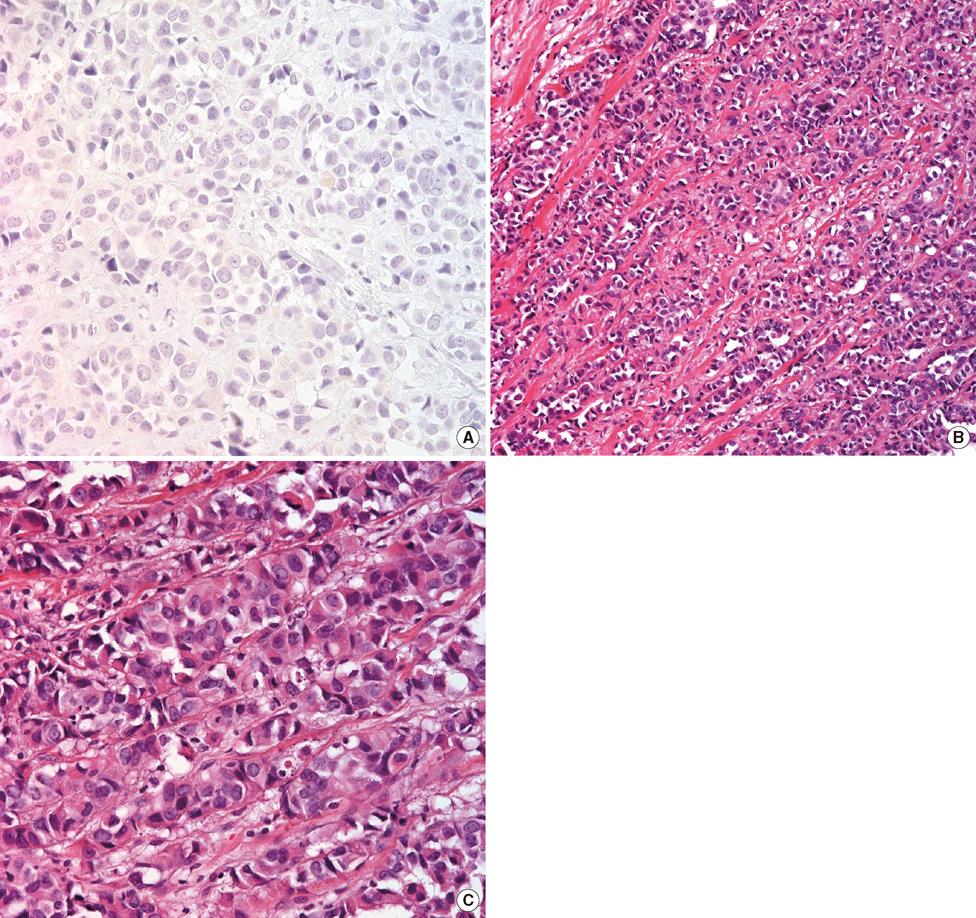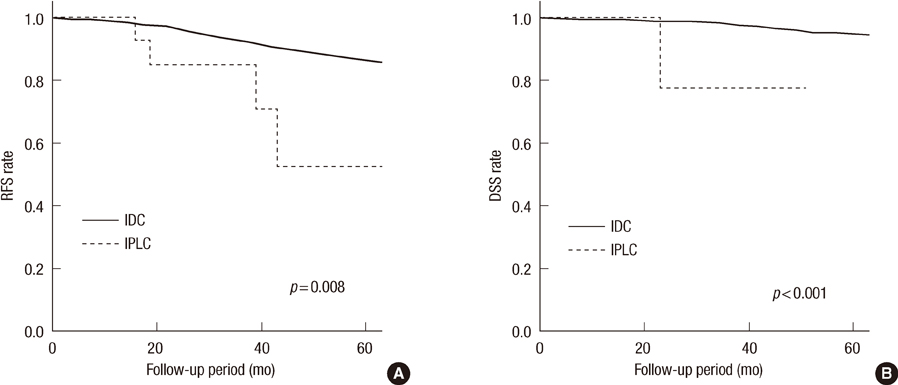J Breast Cancer.
2012 Sep;15(3):313-319. 10.4048/jbc.2012.15.3.313.
Invasive Pleomorphic Lobular Carcinoma of the Breast: Clinicopathologic Characteristics and Prognosis Compared with Invasive Ductal Carcinoma
- Affiliations
-
- 1Division of Breast and Endocrine Surgery, Department of Surgery, Samsung Medical Center, Sungkyunkwan University School of Medicine, Seoul, Korea. jeongeon.lee@samsung.com
- 2Department of Pathology, Samsung Medical Center, Sungkyunkwan University School of Medicine, Seoul, Korea.
- KMID: 2286457
- DOI: http://doi.org/10.4048/jbc.2012.15.3.313
Abstract
- PURPOSE
Invasive pleomorphic lobular carcinoma (IPLC) is a very rare and distinct morphological variant of invasive lobular carcinoma (ILC), characterized by nuclear atypia and pleomorphism contrasted with the cytologic uniformity of ILC. This study evaluated clinicopathologic characteristics and prognosis of IPLC compared with invasive ductal carcinoma (IDC).
METHODS
We retrospectively reviewed the medical records of 35 patients with IPLC and 6,184 patients with IDC, not otherwise specified. We compared the clinicopathologic characteristics, relapse-free survival (RFS) and disease specific survival (DSS) of patients who were surgically treated between January 1997 and December 2010.
RESULTS
Patients with IPLC presented at an older age with larger tumor size, worse histologic grade, higher rates of N3 stage, more multifocal/multicentric tumors, and more nipple-areolar complex involvement than those of patients with IDC. During the follow-up period, the IPLC group experienced five cases (14.3%) of disease recurrence and three cases (8.6%) of disease specific mortality compared with 637 cases (10.4%) of recurrence and 333 cases (5.4%) of disease specific mortality in the IDC group. Univariate analysis using the Kaplan-Meier method revealed that the IPLC group showed a significantly poorer prognosis than that of the IDC group (RFS, p=0.008; DSS, p<0.001). However, after adjusting for clinicopathologic factors, a multivariate analysis showed no statistical differences in RFS (p=0.396) and DSS (p=0.168) between the IPLC and the IDC groups.
CONCLUSION
Our data suggest that patients with IPLC present with poor prognostic factors such as large tumor size, poor histologic grade and advanced stage at diagnosis. These aggressive clinicopathologic characteristics may result in poor clinical outcomes. Although our study could not link IPLC histology to poor prognosis, considering the aggressive characteristics of IPLC, early detection and considerate treatment, including proper surgical and adjuvant intervention, could be helpful for disease progression and survival.
Keyword
MeSH Terms
Figure
Reference
-
1. Page DL, Anderson TJ. Diagnostic Histopathology of the Breast. 1997. Edinburgh: Churchill Livingstone.2. Eusebi V, Magalhaes F, Azzopardi JG. Pleomorphic lobular carcinoma of the breast: an aggressive tumor showing apocrine differentiation. Hum Pathol. 1992. 23:655–662.
Article3. Weidner N, Semple JP. Pleomorphic variant of invasive lobular carcinoma of the breast. Hum Pathol. 1992. 23:1167–1171.
Article4. Yoder BJ, Wilkinson EJ, Massoll NA. Molecular and morphologic distinctions between infiltrating ductal and lobular carcinoma of the breast. Breast J. 2007. 13:172–179.
Article5. Vargas AC, Lakhani SR, Simpson PT. Pleomorphic lobular carcinoma of the breast: molecular pathology and clinical impact. Future Oncol. 2009. 5:233–243.
Article6. Jacobs M, Fan F, Tawfik O. Clinicopathologic and biomarker analysis of invasive pleomorphic lobular carcinoma as compared with invasive classic lobular carcinoma: an experience in our institution and review of the literature. Ann Diagn Pathol. 2012. 16:185–189.
Article7. Buchanan CL, Flynn LW, Murray MP, Darvishian F, Cranor ML, Fey JV, et al. Is pleomorphic lobular carcinoma really a distinct clinical entity? J Surg Oncol. 2008. 98:314–317.
Article8. Bentz JS, Yassa N, Clayton F. Pleomorphic lobular carcinoma of the breast: clinicopathologic features of 12 cases. Mod Pathol. 1998. 11:814–822.9. Edge SB, Byrd DR, Compton CC, Fritz AG, Greene FL, Trotti A. AJCC Cancer Staging Manual. 2010. 7th ed. New York: Springer.10. Allred DC, Harvey JM, Berardo M, Clark GM. Prognostic and predictive factors in breast cancer by immunohistochemical analysis. Mod Pathol. 1998. 11:155–168.11. Harvey JM, Clark GM, Osborne CK, Allred DC. Estrogen receptor status by immunohistochemistry is superior to the ligand-binding assay for predicting response to adjuvant endocrine therapy in breast cancer. J Clin Oncol. 1999. 17:1474–1481.
Article12. Varga Z, Zhao J, Ohlschlegel C, Odermatt B, Heitz PU. Preferential HER-2/neu overexpression and/or amplification in aggressive histological subtypes of invasive breast cancer. Histopathology. 2004. 44:332–338.
Article13. Gennari R, Curigliano G, Rotmensz N, Robertson C, Colleoni M, Zurrida S, et al. Breast carcinoma in elderly women: features of disease presentation, choice of local and systemic treatments compared with younger postmenopasual patients. Cancer. 2004. 101:1302–1310.14. Herbsman H, Feldman J, Seldera J, Gardner B, Alfonso AE. Survival following breast cancer surgery in the elderly. Cancer. 1981. 47:2358–2363.
Article15. Holli K, Isola J. Effect of age on the survival of breast cancer patients. Eur J Cancer. 1997. 33:425–428.
Article16. Jung KW, Park S, Kong HJ, Won YJ, Lee JY, Park EC, et al. Cancer statistics in Korea: incidence, mortality, survival, and prevalence in 2008. Cancer Res Treat. 2011. 43:1–11.
Article17. Orvieto E, Maiorano E, Bottiglieri L, Maisonneuve P, Rotmensz N, Galimberti V, et al. Clinicopathologic characteristics of invasive lobular carcinoma of the breast: results of an analysis of 530 cases from a single institution. Cancer. 2008. 113:1511–1520.
Article18. Rakha EA, El-Sayed ME, Menon S, Green AR, Lee AH, Ellis IO. Histologic grading is an independent prognostic factor in invasive lobular carcinoma of the breast. Breast Cancer Res Treat. 2008. 111:121–127.
Article19. Bane AL, Tjan S, Parkes RK, Andrulis I, O'Malley FP. Invasive lobular carcinoma: to grade or not to grade. Mod Pathol. 2005. 18:621–628.
Article20. Middleton LP, Palacios DM, Bryant BR, Krebs P, Otis CN, Merino MJ. Pleomorphic lobular carcinoma: morphology, immunohistochemistry, and molecular analysis. Am J Surg Pathol. 2000. 24:1650–1656.
Article21. Frolik D, Caduff R, Varga Z. Pleomorphic lobular carcinoma of the breast: its cell kinetics, expression of oncogenes and tumour suppressor genes compared with invasive ductal carcinomas and classical infiltrating lobular carcinomas. Histopathology. 2001. 39:503–513.
Article22. Simpson PT, Reis-Filho JS, Lambros MB, Jones C, Steele D, Mackay A, et al. Molecular profiling pleomorphic lobular carcinomas of the breast: evidence for a common molecular genetic pathway with classic lobular carcinomas. J Pathol. 2008. 215:231–244.
Article
- Full Text Links
- Actions
-
Cited
- CITED
-
- Close
- Share
- Similar articles
-
- Nodular Metastatic Carcinoma from Invasive Lobular Breast Cancer
- Invasive Lobular Carcinoma of the Breast Associated with Mixed Lobular and Ductal Carcinoma In Situ: A Case Report
- Clinicopathologic Characteristics of Apocrine Breast Carcinoma
- Clinical Analysis of an Invasive Lobular Carcinoma in the Breast
- Pathologic Study of Breast Cancer in Korea




